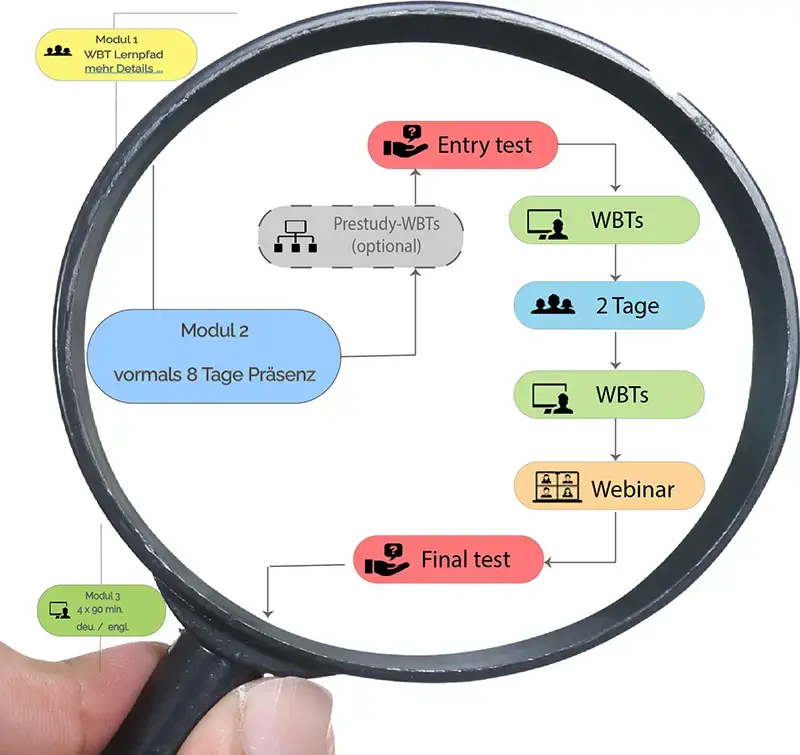The digitization has revolutionized the educational landscape, and companies are faced with the challenge of adapting their training and educational programs to modern learning needs. Blended Learning has proven to be an extremely effective method for combining the advantages of digital education with personal interaction. In this article, we will illuminate the steps through which companies can transform numerous in-person training sessions into Blended Learning pathways. Additionally, we will highlight the benefits of Blended Learning, such as cost savings, flexibility, and improved adaptation of different learning formats to pedagogical needs.
Advantages of Blended Learning
- Cost Savings: A significant advantage of Blended Learning is the substantial cost savings compared to pure face-to-face training. Companies need to invest less in travel expenses, accommodations, and printed materials. This allows for more efficient utilization of training budgets.
- Flexibility: Blended Learning provides employees with the flexibility to integrate their learning into their daily work routines. They can consume learning materials at their convenience, enhancing productivity and reducing workloads.
- Improved Pedagogical Adaptation: Blended Learning enables companies to better tailor training content to individual employee needs. Various content can be presented in different formats to optimize the learning process.
- Increased Engagement: Blended Learning often incorporates multimedia elements, interactive activities, and online discussions, which can significantly enhance learner engagement. These interactive components make the learning experience more immersive and enjoyable, leading to better retention of information.
- Customized Learning Paths: Blended Learning allows for the creation of personalized learning paths. Learners can choose the sequence and pace of their learning, focusing on areas where they need more time and practice. This customization caters to individual learning styles and abilities, resulting in a more effective learning experience.
How to transform extensive Seminars
Assuming a large company has developed a variety of different courses and training programs over the years.
Ohe first step in converting these programs into Blended Learning formats is to include with training staff within the transformation process. These employees possess the necessary pedagogical knowledge to design effective Blended Learning programs.
They are capable of identifying the segments of classroom training that would benefit from conversion into another format, thereby enhancing the overall learning outcomes.

Breaking up an originally extensive classroom course into different learning formats for increased
- flexibility
- efficiency
- economy;
Learning formats and their Advantages
The following table demonstrates that various learning formats offer distinct pedagogical and didactic advantages. The selection of the appropriate format depends on the learning objectives, participant needs, and available resources.
During the transformation of in-person training into Blended Learning pathways, these benefits can be purposefully leveraged to create effective and engaging learning programs.
Learning Format
Advantages
In-Person Training, Seminars, Classroom Courses
- Direct interaction between trainer and participants
- Immediate feedback
- Opportunity for group discussions
- Focused and structured learning environment
E-Learning Modules,
Web-based Trainings (WBTs)
- Self-paced learning
- Flexibility in learning pace and location
- Repetition and deepening of content possible
- Interactive elements like quizzes and simulations
Webinars
- Real-time interaction with experts
- Opportunity for questions and discussions
- Recordings for later use
- Targeted focus on specific topics
Self-Study Phases
- Individual deepening of knowledge
- Time flexibility for participants
- Encourages self-motivation and self-responsibility
In-Person Workshop
- Intensive, hands-on exercises
- Collaborative learning and knowledge sharing
- Trainer support for complex topics
Pre Tests / Final Tests
- Assessment of entry requirements or learning progress and final learning outcomes.
- Ensuring competency acquisition.
- Feedback for participants and content adjustments.
Addressing Challenges during Transformation
One of the challenges when restructuring existing training programs is the need to preserve the respective qualification profiles that have already been validated and tested.
Additionally, the new blended learning paths and their corresponding qualification profiles must align with learners' historical data and mandatory training intervals.
Moreover, additional course units, regardless of their learning format, necessitate specific resources, such as course equipment, instructors with particular skills, rooms of specific size and layout, and more. Ideally, the LMS immediately provides automated resource planning during (appointment) scheduling.

The assistant supports the training staff step by step in entering the metadata of the individual modules of the learning path.
First, one of the predefined learning path templates is selected. These learning path templates are created according to company-specific requirements. The assistant generates a corresponding sequence of suitable input screens.
This also includes capturing specific details, such as regional restrictions or extensions, as well as optional learning units.
The process concludes with a plausibility check.
Summary
The transformation of numerous in-person training sessions into Blended Learning pathways requires careful planning and collaboration with the training staff.
The input of metadata into the LMS is a task that requires time and accuracy. Therefore, it makes sense to delegate this task to the product owner or training personnel responsible for designing the respective training product. TCmanager® LMS can be completed with a dedicated assistant developed for this purpose assists with structured data entry and concludes with a plausibility check.
However, the benefits of Blended Learning, such as cost savings, flexibility, and improved pedagogical adaptation, are well worth the effort. With a structured approach and the utilization of technology, companies can develop more efficient and effective training programs that meet the needs of today's learners.

About SoftDeCC
Since 1998 SoftDeCC is working closely with major training centers and academies. This results in a unique experience with training requirements.
Our Learning Management System is designed to adjust to individual corporate learning processes and address evolving challenges. More...

Get in Touch
Would you like to know more, discuss your current challenge or get a life-demonstration?
Call us to arrange for your personal contact +49 (0)89 / 3090 839 30.
We are looking forward to speaking to you!





